×

×
Don't Miss Upcoming Promotions
Enter your email below to stay updated on our latest specials.
TOLEDO, Ohio – Tire industry veteran Bob Feldbauer has been named Chief Operating Officer at Shrader Tire & Oil. He will assume the role on January 1, 2025.
“
Feldbauer is leaving his position as President and CEO of Jack’s Tire & Oil Management Co., Inc. where he oversaw a 250 percent revenue growth and expanded Jack’s footprint of service throughout 11 western states. Prior to his role at Jack’s, he spent 14 years at Michelin North America in various positions of sales, training, management, and leadership. He ended his time at Michelin as the Director of Commercial Business for the Central Zone.
“I am thrilled to be joining a great, legacy family business that prides itself on operational excellence with both skilled and dedicated employees,” Feldbauer said. “The company’s leadership vision for growth looks to provide many opportunities for Shrader Tire & Oil’s future and I look forward to being a part of it.”
Feldbauer served on the Independent Tire Dealer Group Board of Directors and was a member of the Michelin Dealer Advisory Council. He earned his undergraduate degree and MBA from Charleston Southern University in Charleston, S.C. in 1995 and 1997 respectively. He and his wife, Heather, have two children, Jackson and Kelan. They have relocated to the Toledo area.
Shrader Tire & Oil has become the premier tire and lubricant distributor in the Midwest. The company was founded in 1948 in Toledo, Ohio, and now operates 14 fleet stores, four bulk oil warehouses and two Michelin retread manufacturing plants that service Michigan, Ohio and Indiana. Offering the best in fleet services, bulk oil and lubricants and 24-Hour emergency roadside tire service, Shrader Tire & Ohio has earned its reputation of honesty and integrity in the industry.


By Walt M. Collier | Chevron
An engine coolant and an antifreeze are the same thing. It’s the one fluid that stays in a truck’s system through all seasons, protecting the engine from overheating in hot weather and from freezing up when the temperature drops. Maybe that’s why many operators don’t give it a lot of thought beyond the onset of summer or winter. Yet as we pointed out in a previous article, the coolant system requires more than just a seasonal check. A problem with the coolant system can spread to other parts of the vehicle and lead to costly downtime, which is why an inspection should be a regular part of your preventive maintenance program.
Start with a Visual Assessment
You can tell a lot about the coolant system simply from a visual assessment just by looking at it. Start by checking for leaks from loose hoses, clamps, and the radiator cap. It’s considered best practice to pressure check the system using a readily available pressure tester. If a change in pressure appears during the test, that may be an indicator of a leak in the system.
Make sure that the coolant is at the fill line in the sump. If the level of fluid is below the fill line, you are definitely losing coolant, and the only question is how. If the coolant system is not holding its pressure, you are most likely boiling off water. A coolant is typically a 50/50 or 60/40 mix of glycol and water (depending on the regional climate), and losing water will upset that balance. If you see streaming trails on the outside of the radiator cap, that is an easy way to tell if water is boiling off.
A visual inspection should include an assessment of the fluid itself. The dye in the coolant tends to leach into the plastic of the sump and impede clear visibility, so it is best to open up the radiator cap and look down into the fluid. The color of the coolant is simply a dye and serves no technical purpose. However, if you see brown in the fluid, that could mean rust is present, or that two different coolant types have been mixed. In either case, the system needs to be flushed and drained, and fresh coolant put in. If oil has entered the coolants system, it will be plainly visible as a layer on top of the fluid. Oil in the coolant is a bad sign. It usually means there is coolant in the oil system, too, in which case both the coolant and the oil will need to be completely flushed.
Find a Leak on the Road? Just Add Water
Sometimes a driver may discover a leak on the road. When that happens, there are any number of off-the shelf products you can pour into the system that purport to help stop the leak. However, we don’t recommend that for two reasons: you’re not really fixing the leak at its root cause, and you’re introducing a foreign additive that is going to cause an imbalance in the fluid.
A better (and cheaper) temporary solution is simply to top off the system with water. You may diminish the protection properties of the coolant to a small degree, but it is better than bringing in another chemical, and it should buy you enough time to get to your maintenance shop and get the system fixed.
The important thing is not to mix coolant types. Coolants come in a variety of formulations, whether conventional, fully formulated, hybrid, or a full extended life coolant. If you’re not certain which type you’re using, topping it off with water temporarily is your best quick-fix option. Use bottled water or distilled water – don’t use water from a tap or a hose, which likely has impurities in it.
Keep your Water and Glycol in Balance
One essential tool in your coolant maintenance kit is a refractometer. That is what professional labs use to check the balance of glycol and water and find the freeze point. It is very easy to use and readily available on Amazon or from your lubricant supplier. The reading on the refractometer will help you determine if you need to adjust the water or glycol concentration levels to achieve the appropriate freeze and boiling points for your operating environment and conditions.
Chevron offers a full line of coolants for heavy duty vehicles, both on- and off-highway, as well as our handy Cool Tools Maintenance Kit that includes a refractometer, test strips, sampling tools and more. We also have coolant experts on hand to answer any questions you may have. Remember, a small investment in time and the right tools can save you on costly repairs and downtime in the future.
Keep an eye on your coolant all year ‘round!
Walt M. Collier is the Americas Brand Manager for Delo Engine oils and ancillary products. In this role, Walt oversees the development, deployment, and manages Chevron Delo brand of commercial lubricants products for the Americas. Prior to this role Walt was a Sr. Business Development Specialist working to grow Chevron’s Renewable Fuels business focusing on CNG for transportation fuel and Renewable Natural Gas. He joined the company in 2019 as an experienced hire working as a Business Development Specialist in our Direct Commercial lubricants group focusing on heavy duty engines in fleets, inland/coastal marine, and OEM dealers for North America.

Article courtesy of Chevron Lube Matters
Extending oil drains is a beneficial way of squeezing every ounce of usage out of your lubrication, avoiding waste and saving money. There are several tools and resources available to optimize and extend your drain intervals adequately and safely. Optimizing your equipment’s oil drains is essential to saving resources and reducing costs for the future. Those seeking to safely extend drains and see an additional allocation of the lubricants can do so by inspecting the oil for any contaminants and routinely testing through a laboratory.
Extending your oil drains can result in:
Contact your Shrader Tire and Oil representative today to find out more about extending oil drains and our oil analysis program.
OEM (Original Equipment Manufacturers) Recommendations
OEMs have general recommendations based on intervals such as hours or miles. OEMs can suggest these general recommendations but aren’t always specific to your application. They are unable to determine whether there is useful remaining life in the oil or perhaps the presence of acid, both resulting in unnecessary costs and resource allocation.
Common KPIs (Key Performance Indicators)
Extending oil drains require specific indications that the oil has enough life for further usage. Key Performance Indicators for extending lubricant drain intervals include:
PM vs CBMCBM (condition-based monitoring) is the natural progression of PM (preventive maintenance) to determining what’s best for your equipment. To generate a dependable solution to evaluating the possibility of extending oil drains, routine oil testing and analysis is vital. Fluid analysis programs are the only way to identify whether you are meeting your KPIs. Identifying patterns through CBM results in a higher sense of control over contaminants that directly affect lubrication longevity.
Oil Testing and Analysis
While OEMs offer broad suggestions for scheduling your oil drains, a routine, consistent fluid analysis program can go the extra mile and determine any unusual wear pattern in the equipment, identify and control any contamination present, and determine the suitability of the lubricant for continued use.
Proper training and education in oil analysis is learned best while practicing hands-on with these processes, leading to improved longevity for oil drainage. Being involved in oil analysis cuts costs and prevents unnecessary oil waste by allowing users to decipher when oil drains can be properly extended and the lubricant’s useful remaining life.
Data Management Reports and Sample Reports
Running data management reports and taking action on sample reports can assist users in recognizing problems as they occur. Analyzing patterns based on the results of the reports makes future extension of oil drains increasingly more manageable. Understanding oil sample data and downloading data across data management reports offers users solutions to enhance oil usage. For example, downloading sample data through the Problem Summary Report available in POLARIS Laboratories’ data management system, HORIZON®, identifies KPIs for oil drains.
Acting on maintenance recommendations included in sample reports can streamline the process of identifying suitability within the oil. Sample reports inform users of levels of metal and contamination and can be used as KPI’s to determine drain intervals. Additionally, these reports allow users to view sample history and recommended actions indicated on previously submitted samples for the same component.
Optimize Your Oil Drains
Resources such as condition-based monitoring, oil testing, and analyzing data in oil analysis reports give users opportunities to safely extend oil drains. Understanding acceptable levels of contamination or acids in lubrication instead of hours or miles recommended by OEMs can result in extending drains and using oil for longer. Knowledge identified with KPIs based on oil analysis reports results in extended component hours, decrease in costs associated with labor and lubricants, and less waste.
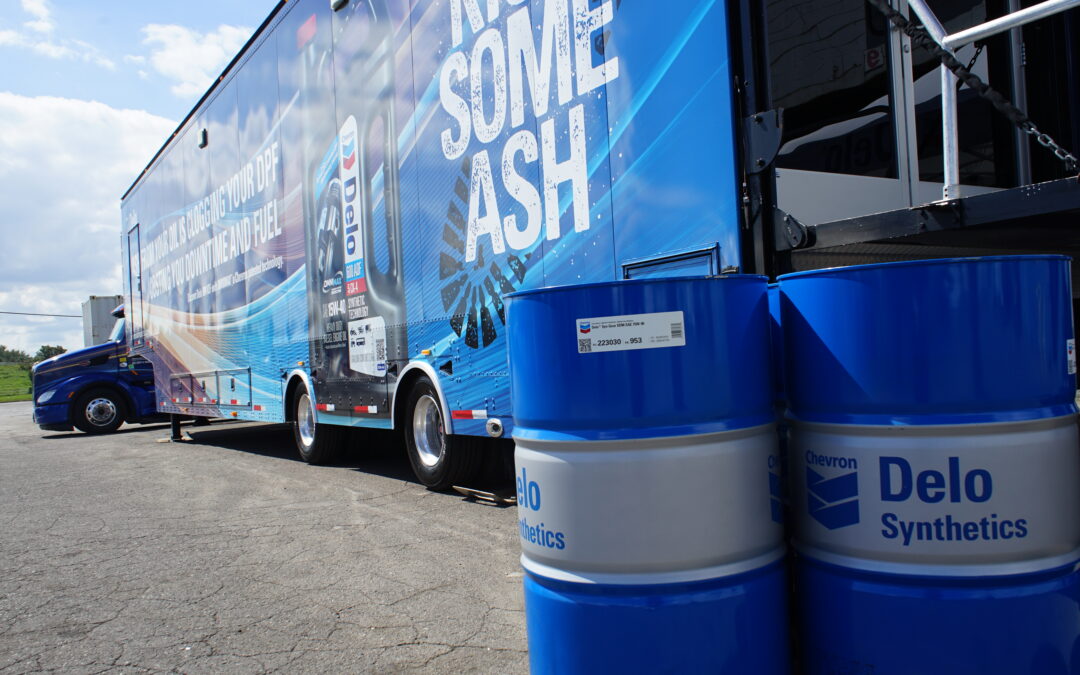
By DOUG DONNELLY
Shrader Tire and Oil hosted two Delo Truck Experience events in September, one at our store in Melvindale, Mich. and the other at our Columbus, Ohio, location.
Chevron takes the Delo Truck across the country giving customers an opportunity to learn more about the product. Inside the Delo trailer are multiple interactive displays that customers can experience and educate themselves about Chevron and Delo.
Shrader Tire and Oil representatives were on hand to talk with customers and potential customers as well. Tours were given of the Shrader Tire and Oil retread plant, bulk oil facility and warehouse.
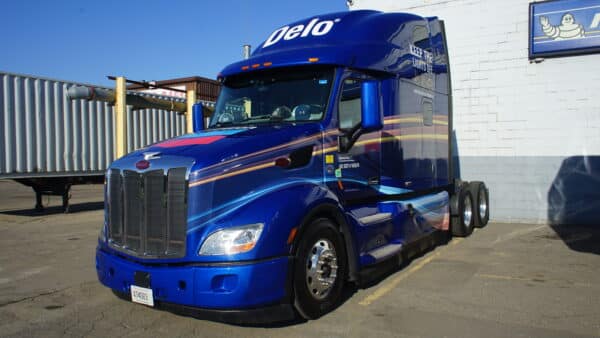
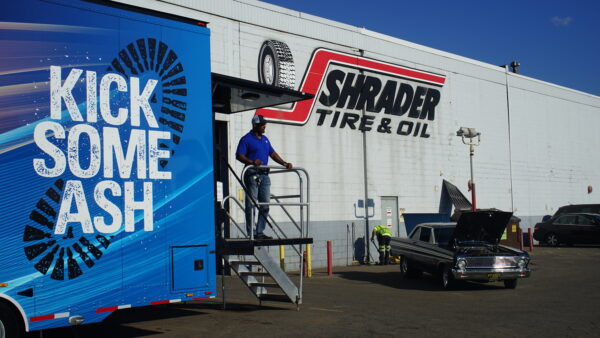
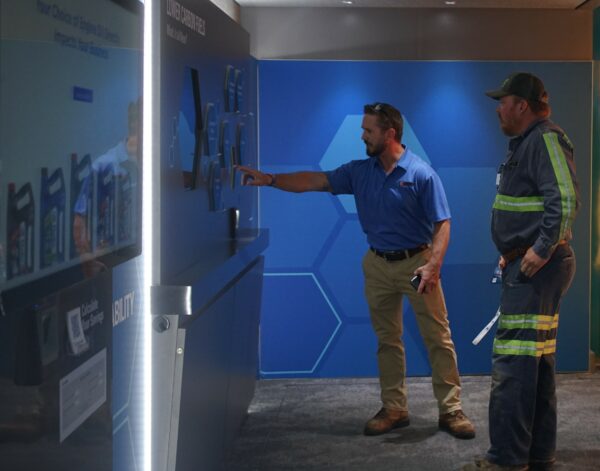
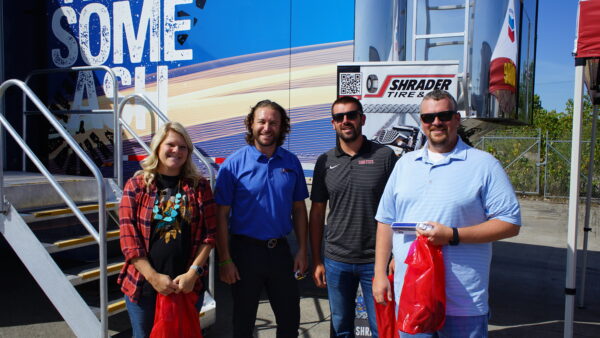

TOLEDO, Ohio (April 22, 2023) – Today is Earth Day in the United States, but in the truck tire retread industry, we believe in celebrating the environment every day.
Recycling end-of-life tires is a major challenge for the tire industry and its customers. Around one billion tires reach the end of their useful lives each year. Recycling is part of a process that includes collecting end-of-life tires, sorting them, and giving them a new purpose. Around 65 percent of them are collected for some form of reuse, roughly 70 percent are recycled to recover their materials, and the remaining 30 percent are generally used for energy recovery.
Truck tire retreads deliver huge savings to fleet managers and owner/operators and have a massive impact on the environment.
With two retread facilities in northwest Ohio and southeast Michigan, Shrader Tire and Oil is part of the recycling process.
It is estimated that nearly 300 million tires from cars and trucks are thrown away by Americans each year, but the use of retreads saves hundreds of millions of gallons of oil, and millions of tires continue a useful life rather than being consigned to a tire pile or landfill.
Simply put, retreading tires conserves oil. The synthetic rubber components in a new medium truck tire require about 22 gallons of oil, but it takes only seven gallons to retread that same tire.
Retreading truck tires in the U.S. reduces carbon emissions by 396,000 tons, or 70 percent annually. Finally, nearly 40 pounds of raw material including rubber, steel and carbon black is saved for every retreaded tire manufactured.
Shrader Tire & Oil is the premier tire and lubricant distributor in the Midwest. With locations in Ohio, Michigan and Indiana, Shrader has 15 truck tire and fleet service centers, two state-of-the-art Michelin retread plants, a bulk lubricant operation and a 24-hour emergency road service network.


TOLEDO, Ohio – Shrader Tire and Oil is celebrating its 75th Birthday on Wednesday, April 19, 2023.
In the spring of 1948, Jim and Bernadine Shrader founded Shrader Tire & Oil in Toledo, Ohio. A true family business, their children Jim Jr., Gerri, and Patti filled roles in the company after school. In the evenings, Jim Sr. would instill the importance of values like honesty, integrity and commitment and customer service as the family sat around the dinner table.
The family-owned company has flourished over the years. In 1985, Jim Shrader Sr. handed the company down to his son. Soon Jim Jr. looked to the commercial trucking market as the next area to expand the business. As the company grew, so did the Shrader family; many of which became the third generation to run the business.
In the year 2000, Jim Shrader Jr. handed the company down to his son, Joe Shrader. Like most of our staff, Joe rose through the ranks in the business, gaining valuable experience along the way by working in all facets of the company.
Even though the Shrader business model has shifted over the years, the foundation and core values that Jim & Bernie believed in still hold true today and practiced by third and fourth-generation members.
Today, with 15 truck tire and fleet service centers, two state-of-the-art Michelin retread plants, and four bulk lubricant operations larger than ever, Shrader Tire & Oil has become the premier tire and lubricant distributor in the Midwest.
By aligning ourselves with Chevron & Michelin, Shrader brings value to our customers for less. In addition to providing the highest quality products in the industry, Shrader offers the best service in the region. Our knowledge and expertise go well beyond our product lines. We strive to create loyal partnerships with our customers while providing measurable solutions for lowering operating costs through our high-performance products and extreme customer service.